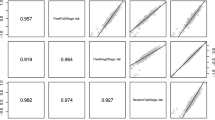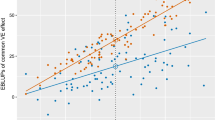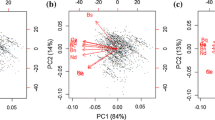Summary
The multi-environment trial, in which a number of genotypes is evaluated over a range of environmental conditions, is a standard experiment in plant breeding in general, and variety testing in particular. Useful statistical models for the analysis of multi-environment trials, with emphasis on the analysis of genotype by environment interaction, can be found in the classes of linear and bilinear models. Statistical properties of the most important representatives of these model classes are shortly reviewed. Structural differences between the models stem from: (1) the inclusion of random model terms in addition to fixed model terms; (2) the representation of the interaction by additive or multiplicative parameters; (3) the incorporation of concomitant variables on the levels of the environmental factor. For models with bilinear multiplicative structure for the interaction it is described how the interaction can be visualized by biplots. An illustration of the application of the models and biplots is given in a companion paper.
Similar content being viewed by others
References
Cornelius, P.L., 1993. Statistical tests and retention of terms in additive main effects and multiplicative interaction model for cultivar trials. Crop Sci. 33: 1186–1193.
Davies, P.T. & M.K.S. Tso, 1982. Procedures for reduced-rank regression. Appl. Stat. 31: 244–255.
Denis, J.B., 1980. Analyse de régression factorielle. Biom. Praxim. 20: 1–34.
Denis, J.B., 1988. Two way analysis using covariates. Statistics 19: 123–132.
Denis, J.B., 1991. Ajustement de modèles linéaires et bilinéaires sous contraintes linéaires avec données manquantes. Rev. Stat. Appl. XXXIX: 5–24.
Denis, J.B. & J.C. Gower, 1992. Biadditive models: Technical report. Laboratoire de Biométrie. INRA-Versailles.
Denis, J.B. & J.C. Gower, 1994. Biadditive models. Letter to the editor. Biometrics 50: 310–311.
Finlay, K.W. & G.N. Wilkinson. 1963. The analysis of adaptation in a plant-breeding programme. Aust. J. Agric. Res. 14: 742–754.
Gabriel, K.R., 1971. Biplot display of multivariate matrices with application to principal componentalysis. Biometrika 50: 453–467.
Gabriel, K.R., 1978. Least squares approximation of matrices by additive and multiplicative models. J.R. Stat. Soc. B. 40: 186–196.
Gabriel, K.R. & S. Zamir, 1979. Lower rank approximations of matrices by least squares with any choice of weights. Technometrics 21: 489–498.
Gauch, H.G., 1988. Model selection and validation for yield trails with interaction. Biometrics 44: 705–715.
Gauch, H.G., 1992. Statistical analysis of regional yield trials. Elsevier. Amsterdam.
Genstat 5 Committee 1993. Genstat 5 release 3 reference manual. Clarendon Press, Oxford.
Gollob, H.F., 1968. A statistical model which combines features of factor analytic and analysis of variance techniques. Psychometrika 33: 73–115.
Henderson, C.R., 1963. Selection index and expected genetic advance. In: W.D. Hanson & H.F. Robinson (Eds). Statistical genetics and plant breeding. pp. 141–163 National Academy of Sciences, National Reseaerch Council, Washington.
Johnson, D.E. & F.A. Graybill, 1972. An analysis of a two-way model with interaction and no replication. J. Am. Stat. Ass. 67: 862–868.
Kempton, R.A., 1984. The use of biplots in interpreting variety by environment interactions. J. Agric. Sci. Camb. 103: 123–135.
Mandel, J., 1961. Non-additivity in two-way analysis of variance. J. Am. Stat. Ass. 56: 878–888.
Mandel, J. 1969. The partitioning of interaction in analysis of variance. J. Res. NBS B 73B: 309–328.
Patterson, H.D., 1978. Routine least squares estimation of variety means in incomplete tables. J. Natn. Inst. Agric. Bot. 14: 401–412.
Patterson, H.D. & R. Thompson, 1971. Recovery of inter-block information when block sizes are unequal. Biometrika 58: 545–554.
Perkins, J.M., 1972. The principal components analysis of genotype environmental interactions and physical measures of the environment. Heredity 29: 51–70.
Robinson, D.L., 1987. Estimation and use of variance components. Statistician 36: 3–14.
Robinson, G.K., 1991. That BLUP is a good thing: the estimation of random effects. Stat. Sci. 6: 15–51.
Searle, S.R., 1971. Linear Models. Wiley, New York.
Searle, S.R., G. Casella & C.E. McCulloch, 1992. Variance components. Wiley, New York.
Snedecor, G.W. & W.G. Cochran, 1980. Statistical Methods. 7th edn. Iowa State University Press, Ames.
Ter Braak, C.J.F., 1990. Interpreting canonical correlation analysis through biplots of structure correlations and weights. Psychometrika 55: 519–531.
Ter Braak, C.J.E. & C.W.N. Looman, 1994. Biplots in reduced-rank regression. Biom. J. 36: 983–1003.
van Eeuwijk, F.A., 1992. Interpreting genotype-by-environment interaction using redundancy analysis. Theor. Appl. Genet. 85: 89–100.
van Eeuwijk, F.A. & A. Elgersma, 1993. Incorporating environmental information in an analysis of genotype by environment interaction for seed yield in perennial ryegrass. Heredity 70: 447–457.
van Eeuwijk, F.A., 1995. Multiplicative interaction in generalized linear models. Biometrics: in press.
van Eeuwijk, F.A., L.C.P. Keizer & J.J. Bakker, 1995. Linear and bilinear models for the analysis of multi-environment trials: II. An application to data from the Dutch Maize Variety Trials. Euphytica this issue.
Yates, F. & W.G. Cochran. 1938. The analysis of groups of experiments. J. Agric. Sci. Camb. 28: 556–580.
Author information
Authors and Affiliations
Rights and permissions
About this article
Cite this article
van Eeuwijk, F.A. Linear and bilinear models for the analysis of multi-environment trials: I. An inventory of models. Euphytica 84, 1–7 (1995). https://doi.org/10.1007/BF01677551
Received:
Accepted:
Issue Date:
DOI: https://doi.org/10.1007/BF01677551




